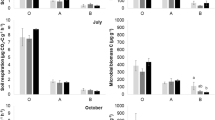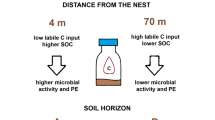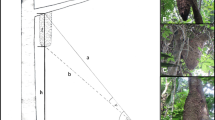Abstract
Wood ants are common in temperate forests, and while building their nests and foraging for food, they transfer large amounts of organic matter and nutrients. Here, we tested the hypothesis that wood ants generate natural gradients of labile carbon (C) inputs into the soil surrounding their nests. We selected five medium-sized wood ant (Formica aquilonia) nests in a coniferous temperate forest and established sampling points at distances of 4, 30 and 70 m from each nest. Throughfall (honeydew + aboveground vegetation leachates) and litterfall were collected regularly during a vegetative season and were analysed for labile organic C content. In addition, soil from the organic horizon (Oe + Oa), surface mineral horizon (A) and subsoil mineral horizon (B) was collected and analysed for organic matter and nutrient contents. The labile C input in throughfall increased with distance from the nest (it was 1.5-fold greater at 70 m than at 4 m). C input changed during the vegetative season and was highest in June. Litterfall was not affected by the distance from the nest. Organic matter and nutrient contents were unaffected by distance from the nest in surface soil horizons but were significantly higher near the nest (4 m) than 70 m from the nest in the subsoil mineral horizon, suggesting that surface soils are less affected by the labile C inputs than subsoils. Finally, we suggest that the gradients in labile C input surrounding wood ant nests can be used to study the effects of labile C input changes on soil properties.


Similar content being viewed by others
References
Berg B, McClaugherty C (2008) Plant litter. Decomposition, humus formation, carbon sequestration. Springer-Verlag, Berlin Heidelberg
Bertin C, Yang XH, Weston LA (2003) The role of root exudates and allelochemicals in the rhizosphere. Plant Soil 256:67–83
Bradford MA, Fierer N, Reynolds JF (2008) Soil carbon stocks in experimental mesocosms are dependent on the rate of labile carbon, nitrogen and phosphorus inputs to soils. Funct Ecol 22:964–974
Brady NC, Weil RR (2002) The nature and properties of soils. Prentice-Hall, Upper Saddle River, New Jersey
Ceulemans R, Janssens IA, Jach ME (1999) Effects of CO2 enrichment on trees and forests: lessons to be learned in view of future ecosystem studies. Ann Bot-London 84:577–590
Chigineva NI, Aleksandrova AV, Tiunov AV (2009) The addition of labile carbon alters litter fungal communities and decreases litter decomposition rates. Appl Soil Ecol 42:264–270
Dixon T (2005) Insect herbivore—host dynamics. In: Tree-dwelling aphids. Cambridge University Press, Cambridge
Don A, Kalbitz K (2005) Amounts and degradability of dissolved organic carbon from foliar litter at different decomposition stages. Soil Biol Biochem 37:2171–2179
Fontaine S, Barot S, Barre P, Bdioui N, Mary B, Rumpel C (2007) Stability of organic carbon in deep soil layers controlled by fresh carbon supply. Nature 450:277–281
Frouz J, Rybníček M, Cudlín P, Chmelíková E (2008) Influence of the wood ant, Formica polyctena, on soil nutrient and the spruce tree growth. J Appl Entomol 132:281–284
Frouz J, Jílková V, Sorvari J (2016) Contribution of wood ants to nutrient cycling and ecosystem function. In: Stockan JA, Robinson EJH (eds) Wood ant ecology and conservation. Cambridge University Press, Cambridge, pp 207–220
Ghani A, Dexter M, Perrott KW (2003) Hot-water extractable carbon in soils: a sensitive measurement for determining impacts of fertilisation, grazing and cultivation. Soil Biol Biochem 35:1231–1243
Gunina A, Kuzyakov Y (2015) Sugars in soil and sweets for microorganisms: review of origin, content, composition and fate. Soil Biol Biochem 90:87–100
Hagedorn F, Spinnler D, Bundt M, Blaser P, Siegwolf R (2003) The input and fate of new C in two forest soils under elevated CO2. Glob Chang Biol 9:862–872
Haohao W, Xingkai X, Cuntao D, TuanSheng L, Weiguo C (2017) Effect of carbon and nitrogen addition on nitrous oxide and carbon dioxide fluxes from thawing forest soils. Int Agrophys 31:339–349
Hopkins FM, Filley TR, Gleixner G, Lange M, Top SM, Trumbore SE (2014) Increased belowground carbon inputs and warming promote loss of soil organic carbon through complementary microbial responses. Soil Biol Biochem 76:57–69
Hothorn T, Bretz F, Westfall P (2008) Simultaneous inference in general parametric models. Biom J 50:346–363
Hyvönen R, Ågren GI, Linder S, Persson T, Cotrufo MF, Ekblad A, Freeman M, Grelle A, Janssens IA, Jarvis PG, Kellomäki S, Lindroth A, Loustau D, Lundmark T, Norby RJ, Oren R, Pilegaard K, Ryan MG, Sigurdsson BD, Strömgren M, van Oijen M, Wallin G (2007) The likely impact of elevated [CO2], nitrogen deposition, increased temperature and management on carbon sequestration in temperate and boreal forest ecosystems: a literature review. New Phytol 173:463–480
IPCC (2007) Climate change 2007: the physical science basis. In: Contribution of working group I to the fourth assessment report of the intergovernmental report on climate change. Cambridge University Press, Cambridge, pp 749–845
Isidorov VA, Smolewska M, Purzynska-Pugacewicz A, Tyszkiewicz Z (2010) Chemical composition of volatile and extractive compounds of pine and spruce leaf litter in the initial stages of decomposition. Biogeosciences 7:2785–2794
Jílková V, Matějíček L, Frouz J (2011) Changes in the pH and other soil chemical parameters in soil surrounding wood ant (Formica polyctena) nests. Eur J Soil Biol 47:72–76
Jílková V, Šebek O, Frouz J (2012) Mechanisms of pH change in wood ant (Formica polyctena) nests. Pedobiologia 55:247–251
Jílková V, Dufková K, Cajthaml T (2019) Decomposition of labile and recalcitrant coniferous litter fractions affected by temperature during the vegetative season. J Forest Res. https://doi.org/10.1007/s11676-018-00877-7
Jobbágy EG, Jackson RB (2000) The vertical distribution of soil organic carbon and its relation to climate and vegetation. Ecol Appl 10:423–436
Joly F-X, Fromin N, Kiikkilä O, Hättenschwiler S (2016) Diversity of leaf litter leachates from temperate forest trees and its consequences for soil microbial activity. Biogeochemistry 129:373–388
Kalbitz K, Kaiser K, Bargholz J, Dardenne P (2006) Lignin degradation controls the production of dissolved organic matter in decomposing foliar litter. Eur J Soil Sci 57:504–516
Kammer A, Schmidt MWI, Hagedorn F (2012) Decomposition pathways of 13C-depleted leaf litter in forest soils of the Swiss Jura. Biogeochemistry 108:395–411
Karl TR, Melillo JM, Peterson TC (2009) Global climate change impacts in the United States. Cambridge University Press, New York
Kilpeläinen J, Finér L, Neuvonen S, Niemelä P, Domisch T, Risch AC, Jurgensen MF, Ohashi M, Sundström L (2009) Does the mutualism between wood ants (Formica rufa group) and Cinara aphids affect Norway spruce growth? Forest Ecol Manag 257:238–243
Lal R (2008) Soil carbon stocks under present and future climate with specific reference to European ecoregions. Nutr Cycl Agroecosyst 81:113–127
Melillo JM, Butler S, Johnson J, Mohan J, Steudler P, Lux H, Burrows E, Bowles F, Smith R, Scott L, Vario C, Hill T, Burton A, Zhou Y-M, Tang J (2011) Soil warming, carbon–nitrogen interactions, and forest carbon budgets. PNAS 108:9508–9512
Miles P (2000) Vzácní mravenci v CHKO Blanský les. Formica 3
Nieminen JK, Pohjola P (2014) Labile carbon addition affects soil organisms and N availability but not cellulose decomposition in clear-cut Norway spruce forests. Boreal Environ Res 19:257–266
Norby RJ, Wullschleger SD, Gunderson CA, Johnson DW, Ceulemans R (1999) Tree responses to rising CO2 in field experiments: implications for the future forest. Plant Cell Environ 22:683–714
Paterson E, Osler G, Dawson LA, Gebbing T, Sim A, Ord B (2008) Labile and recalcitrant plant fractions are utilised by distinct microbial communities in soil: independent of the presence of roots and mycorrhizal fungi. Soil Biol Biochem 40:1103–1113
Peters K, BrucknerSchatt G (1995) The dry deposition of gaseous and particulate nitrogen compounds to a spruce stand. Water Air Soil Poll 85:2217–2222
Pinheiro J, Bates D, DebRoy S, Sarkar D, Core Team R (2016) Nlme: linear and nonlinear mixed effects models. R package version 3:1–123 http://CRAN.R-project.org/package=nlme
Pokarzhevskij AD (1981) The distribution and accumulation of nutrients in nests of ant Formica polyctena (Hymenoptera, Formicidae). Pedobiologia 21:117–124
Portillo-Estrada M, Korhonen JFJ, Pihlatie M, Pumpanen J, Frumau AKF, Morillas L, Tosens T, Niinemets U (2013) Inter- and intra-annual variations in canopy fine litterfall and carbon and nitrogen inputs to the forest floor in two European coniferous forests. Ann Forest Sci 70:367–379
Qiao N, Schaefer D, Blagodatskaya E, Zou X, Xu X, Kuzyakov Y (2014) Labile carbon retention compensates for CO2 released by priming in forest soils. Glob Chang Biol 20:1943–1954
R Core Team (2018) R: a language and environment for statistical computing. R Foundation for Statistical Computing, Vienna https://www.R-project.org/
Rosengren R, Sundström L (1991) The interaction between red wood ants, Cinara aphids, and pines. A ghost of mutualism past? In: Huxley CR, Cutler DF (eds) Ant-plant interactions. Oxford University Press, Oxford, pp 80–91
Schmidt MWI, Torn MS, Abiven S, Dittmar T, Guggenberger G, Janssens IA, Kleber M, Kögel-Knabner I, Lehmann J, Manning DAC, Nannipieri P, Rasse DP, Weiner S, Trumbore SE (2011) Persistence of soil organic matter as an ecosystem property. Nature 478:49–56
Sparling G, Vojvodic-Vukovic M, Schipper LA (1998) Hot-water-soluble C as a simple measure of labile soil organic matter: the relationship with microbial biomass C. Soil Biol Biochem 30:1469–1472
Stadler B, Michalzik B (1998) Aphid infested Norway spruce are “hot spots” in throughfall carbon chemistry in coniferous forests. Can J For Res 28:1717–1722
Stadler B, Michalzik B, Müller T (1998) Linking aphid ecology with nutrient fluxes in a coniferous forest. Ecology 79:1514–1525
Stockan JA, Robinson EJH, Trager J, Yao I, Seifert B (2016) Introducing wood ants: evolution, phylogeny and distribution. In: Stockan JA, Robinson EJH (eds) Wood ant ecology and conservation. Cambridge University Press, Cambridge, pp 1–36
Tyrrell ML, Ross J, Kelty M (2012) Carbon dynamics in the temperate forest. In: Ashton MS, Tyrrell ML, Spalding D, Gentry B (eds) Managing forest carbon in a changing climate. Springer, New York, pp 77–107
Wang Q, Wang Y, Wang S, He T, Liu L (2014) Fresh carbon and nitrogen inputs alter organic carbon mineralization and microbial community in forest deep soil layers. Soil Biol Biochem 72:145–151
Whittaker JB (1991) Effects of ants on temperate woodland trees. In: Huxley CR, Cutler DF (eds) Ant-plant interactions. Oxford University Press, Oxford, pp 67–79
Wiesmeier M, Prietzel J, Barthold F, Spörlein P, Geuß U, Hangen E, Reischl A, Schilling B, von Lützow M, Kögel-Knabner I (2013) Storage and drivers of organic carbon in forest soils of southeast Germany (Bavaria)—implications for carbon sequestration. Forest Ecol Manag 295:162–172
Acknowledgements
The authors thank Jiří Petrásek, Kristýna Hošková, Ota Rauch, Josef Starý, Pavlína Stuchlá, Jan Hanzelka and Jitka Hubačová for help with field sampling and laboratory analyses and Bruce Jaffee for the English revision of the manuscript.
Funding
This study was supported by the Czech Science Foundation (17-08717S), the Czech Academy of Sciences (L200961602), and the Ministry of Education, Youth and Sports of the Czech Republic - MEYS (projects LM2015075, EF16_013/0001782). Part of the equipment used for this study was purchased from the Operational Programme Prague - Competitiveness (Project CZ.2.16/3.1.00/21516). Institutional funding for K. J. was provided by the Center for Geosphere Dynamics (UNCE/SCI/006).
Author information
Authors and Affiliations
Corresponding author
Additional information
Publisher’s note
Springer Nature remains neutral with regard to jurisdictional claims in published maps and institutional affiliations.
Rights and permissions
About this article
Cite this article
Jílková, V., Jandová, K., Vacířová, A. et al. Gradients of labile carbon inputs into the soil surrounding wood ant nests in a temperate forest. Biol Fertil Soils 56, 69–79 (2020). https://doi.org/10.1007/s00374-019-01402-6
Received:
Revised:
Accepted:
Published:
Issue Date:
DOI: https://doi.org/10.1007/s00374-019-01402-6




